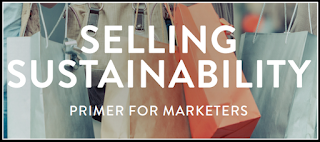Sustainability may be a hot and growing mega-trend, but selling sustainability is by no means easy. Sustainability is destined be the new normal, however, the question on marketers minds is how to get from here to there. For many green businesses there will not be a future if they are incapable of capitalizing on sustainability in today's market.
There is increasing demand for greener products and services. A growing number of people want sustainable products and services. The benefits for business include decreased operating costs and, less risk exposure. People and the planet benefit from healthier products and services. So why doesn't sustainability sell itself.
According to a 2015 BSR and Futerra report, "93 percent of global consumers want to see more of the brands they use support worthy social and/or environmental issues, and three out of four teenagers say they want to buy more sustainable products."
The same report offers a framework for marketers who are struggling to make sustainability pay. Despite the claims that consumers want sustainability, marketers continue to see a disconnect between these claims and buying behavior. What sustainability marketers are looking for is an effective framework to sell sustainable products and services.
The BSR and Futerra report Selling Sustainability: Primer for Marketers, draws upon the long-standing collaborative effort with the Sustainable Lifestyles Frontier Group and eight member brands (AT&T, Carlsberg, eBay, Johnson & Johnson, L’Oreal, McDonald’s, Wal-Mart and Waste Management).
The three primary things that marketers can take from the report are
1. Offering consumers more value from sustainability 2. Building functional, emotional and social benefits 3. Timing matters
Value
Consumers want to know what is in it for them. This should be obvious to most markers whether or not they specialize in sustainability. Surprisingly, the report suggests that this is something that is often neglected in sustainable product and behavior campaigns. To create and deliver greater value for consumers out of sustainable products, marketers need to reduce barriers (i.e. lack of skills, motivation, infrastructure or beliefs).
Functional, Social, Emotional
Consumers need to have the benefits (functional, social, emotional) explained in more detail. For example for electric cars the barriers include price and range anxiety. The benefits include reduced fuel costs (functional) and status benefits (social). This is about what the product or service can do as opposed to the product or service itself. This breaks down into three components, functional (getting a specific task done or achieving a functional goal), social (how the consumer wants to be perceived by others), and emotional (how the customer feels or wants to feel).
Timing
In the world of sustainability timing is even more important than it is in traditional marketing. You have to reach consumers at the right time and the right place. In the most general sense, going to market with a sustainable product or service before your market understands the need, is an uphill battle that is doomed to fail. More specifically there are times during the day when your sustainability message is more likely to reach a receptive consumers.
"For behavior change campaigns it’s especially important to track these changes. The best moment to affect a habit, like recycling, is to reach the consumer at their point of behavior (PoB)."
Marketers need to create value by reducing barriers and offering benefits (functional, beneficial and emotional)in a timely fashion. According to the report this means, "your value proposition should emerge stronger and clearer."
Click here to download the report.
- Blogger Comment
- Facebook Comment
Subscribe to:
Post Comments
(
Atom
)

0 comments:
Post a Comment